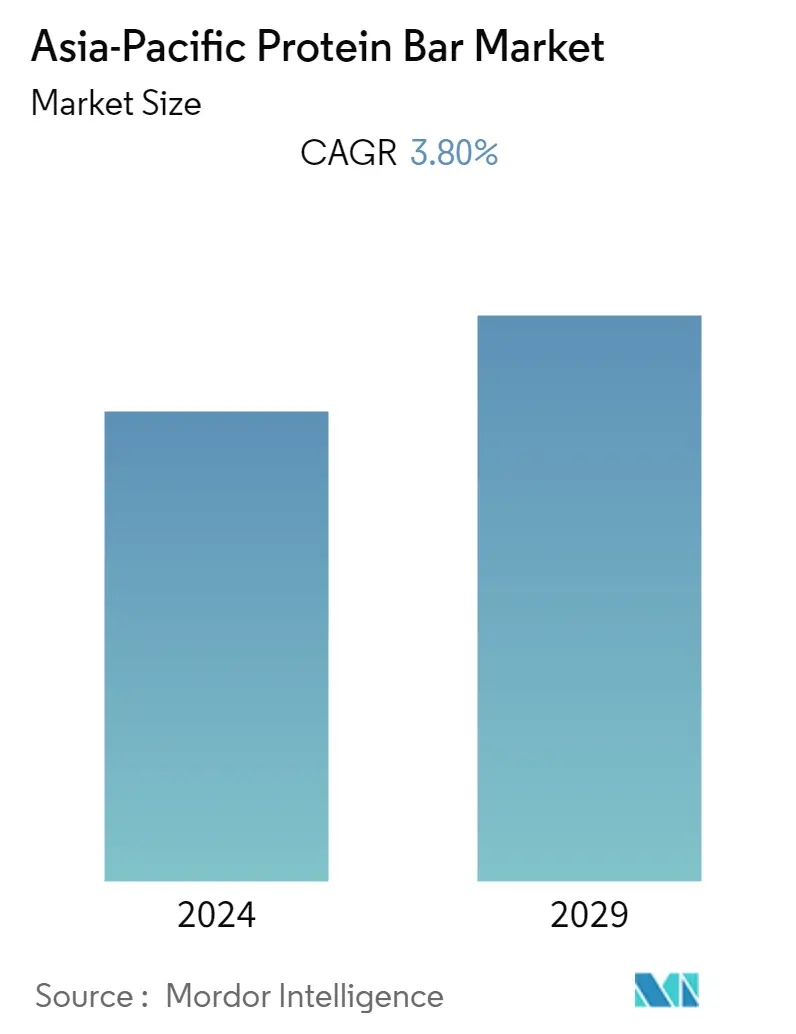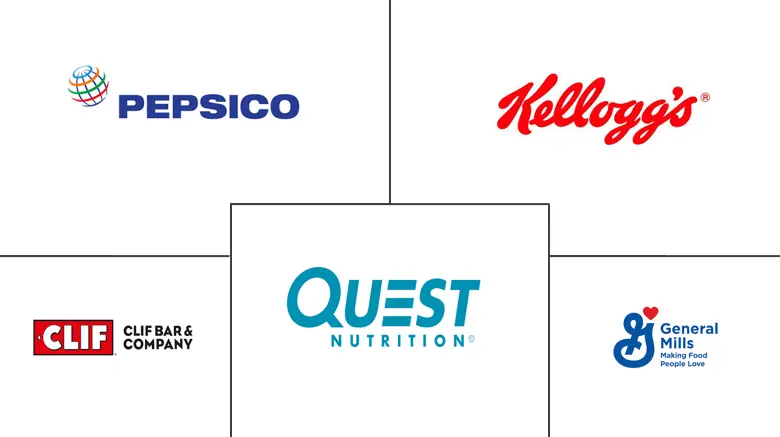Market Size of Asia-Pacific Protein Bar Industry

| Study Period | 2019 - 2029 |
| Base Year For Estimation | 2023 |
| Forecast Data Period | 2024 - 2029 |
| Historical Data Period | 2019 - 2022 |
| CAGR | 3.80 % |
| Market Concentration | High |
Major Players
*Disclaimer: Major Players sorted in no particular order |
APAC Protein Bars Market Analysis
The Asia-Pacific protein bar market is projected to register a CAGR of 3.8% during the forecast period, 2020-2025.
- The increasing demand for convenience foods is driving the protein bar market. The major consumers not only include sports athletes, but also those who want to have a wholesome meal without the trouble of cooking. Consumers prefer buying protein bars for various purposes, such as weight management, improving muscle mass, and increasing energy. Furthermore, rising demand for free-from protein bars, such as soy-free, gluten-free, and allergen-free, among others, paired with the clean label is further driving the market growth. For instance, consumers with celiac disease are seeking for gluten-free products.
- Moreover, leading companies are adopting different strategies to compete with the other leading players, based on product offerings, ingredients, price, quality, and marketing activities. The companies are also expanding their distribution channels to maintain their positions in the market, while expanding their consumer reach within the country.
- However, inclination toward other alternative protein-rich diets and high sugar-content in the protein bars are the major factors restraining the market growth.
APAC Protein Bars Industry Segmentation
The Asia-Pacific protein bar market is segmented by distribution channel into supermarkets/hypermarkets, convenience stores, specialist retail stores, online stores, and other distribution channels. Additionally, the study provides an analysis of the protein bar market in the emerging and established markets across Asia-Pacific, including China, Japan, India, Australia, and Rest of Asia-Pacific.
| By Distribution Channel | |
| Supermarkets/Hypermarkets | |
| Convenience Stores | |
| Specialty Stores | |
| Online Stores | |
| Other Distribution Channels |
| By Country | |
| China | |
| Japan | |
| India | |
| Australia | |
| Rest of Asia-Pacific |
Asia-Pacific Protein Bar Market Size Summary
The Asia-Pacific protein bar market is experiencing growth driven by the increasing demand for convenience foods, appealing to a broad consumer base that includes not only athletes but also individuals seeking easy meal solutions. The market is further propelled by a rising interest in protein bars that cater to specific dietary needs, such as gluten-free and allergen-free options, aligning with the clean label trend. Companies are actively competing through diverse strategies, focusing on product differentiation, ingredient quality, and expanded distribution channels to enhance their market presence. However, the market faces challenges from the growing popularity of alternative protein-rich diets and concerns over the high sugar content in protein bars.
The expansion of e-commerce has significantly influenced the protein bar market, with online platforms offering consumers a convenient shopping experience and a wide variety of product choices. This shift has provided manufacturers with new opportunities to reach a broader audience and improve profit margins. In Japan, the market is particularly vibrant, driven by a preference for plant-based nutritional products and a health-conscious population. The competitive landscape in the Asia-Pacific region is characterized by numerous regional and domestic players, with major companies like PepsiCo Inc., The Kellogg Company, and Clif Bar & Company leading the market through strategic mergers, acquisitions, and product innovations.
Asia-Pacific Protein Bar Market Size - Table of Contents
-
1. MARKET DYNAMICS
-
1.1 Market Drivers
-
1.2 Market Restraints
-
1.3 Porter's Five Forces Analysis
-
1.3.1 Threat of New Entrants
-
1.3.2 Bargaining Power of Buyers/Consumers
-
1.3.3 Bargaining Power of Suppliers
-
1.3.4 Threat of Substitute Products
-
1.3.5 Intensity of Competitive Rivalry
-
-
-
2. MARKET SEGMENTATION
-
2.1 By Distribution Channel
-
2.1.1 Supermarkets/Hypermarkets
-
2.1.2 Convenience Stores
-
2.1.3 Specialty Stores
-
2.1.4 Online Stores
-
2.1.5 Other Distribution Channels
-
-
2.2 By Country
-
2.2.1 China
-
2.2.2 Japan
-
2.2.3 India
-
2.2.4 Australia
-
2.2.5 Rest of Asia-Pacific
-
-
Asia-Pacific Protein Bar Market Size FAQs
What is the current Asia-Pacific Protein Bar Market size?
The Asia-Pacific Protein Bar Market is projected to register a CAGR of 3.80% during the forecast period (2024-2029)
Who are the key players in Asia-Pacific Protein Bar Market?
General Mills Inc. , Clif Bar & Company , Quest Nutrition, LLC, PepsiCo, Inc. and The Kellogg Company are the major companies operating in the Asia-Pacific Protein Bar Market.

